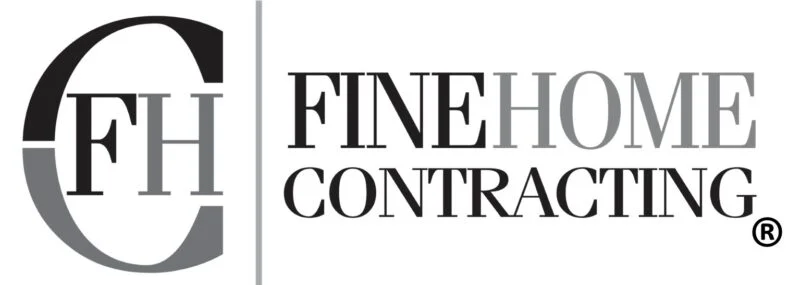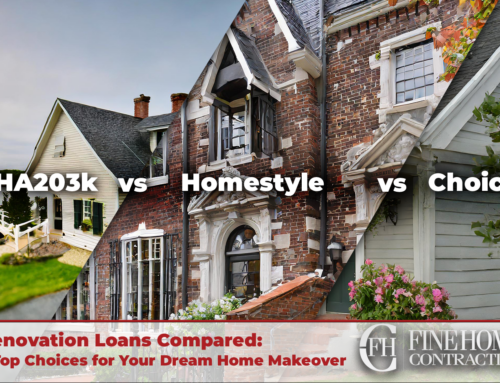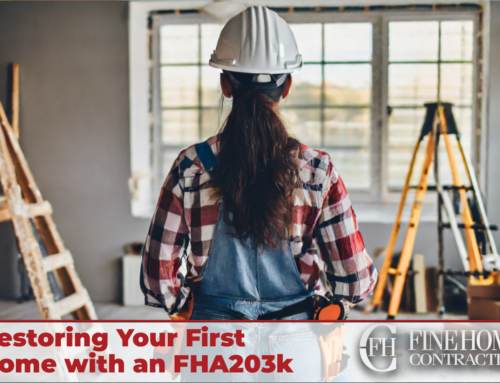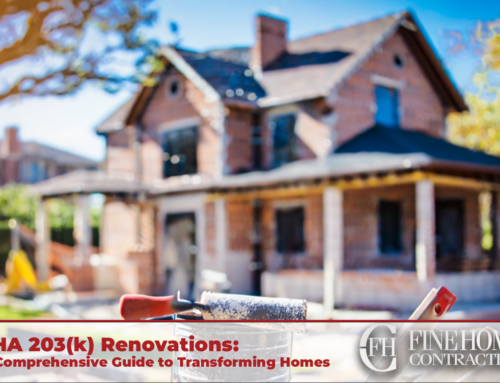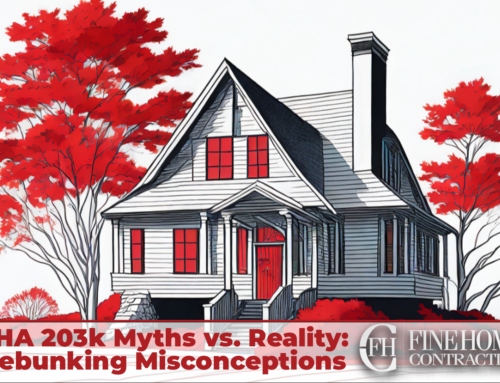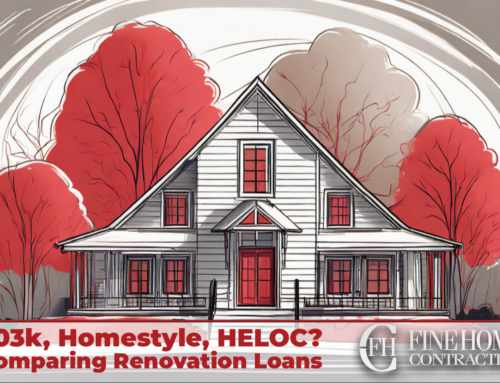Taking on home renovations along with buying a home for the first time can feel daunting. Many first-time buyers dream of customizing a place to fit their style but don’t have the savings for costly renovations. This is where an FHA 203(k) loan can help. A 203(k) allows you to roll the financing for both purchasing and renovating a home into one mortgage. Whether you’re trouble wrangling the requirements of the FHA program, or trying to get a feel on how long your 203k could take, we’re here as a resource for you! This article will run through the most commonly asked questions about FHA203(k)s, and for those with unanswered questions, we’re happy to talk over your plans and provide tips.
What is an FHA 203(k) Loan?
An FHA 203(k) loan is a mortgage insured by the Federal Housing Administration that allows buyers to finance both the purchase and renovation of a home with just one mortgage. It is an attractive option for first-time homebuyers interested in fixing up a older or damaged home.

Benefits of FHA 203(k) Loans
- Finance Home Purchase and Renovation – The key advantage of an FHA 203(k) is it allows you to wrap the mortgage for purchasing the home and the funds for renovating it into one loan. This avoids having to take out and coordinate multiple loans.
- Low Down Payment Options – FHA 203(k) loans only require a 3.5% down payment, making them more accessible than conventional loans that require 20% down. There are even some 203(k) programs with 0% down options.
- Flexible Credit Guidelines – 203(k) loans have more flexible credit standards than conventional loans. You may qualify even with a credit score around 580 and some past issues on your report.
Homes Eligible for FHA 203(k) Loans
Fixer-Uppers
The FHA 203(k) program is designed for homes that need work, ranging from minor repairs to full gut renovations. The home must be structurally sound to qualify.
Condos and Townhomes
In addition to single family homes, condos and townhomes may also be eligible for 203(k) financing. However, there may be additional HOA rules to consider.
FHA 203(k) Loan Process
- Find the Right Property – Work with a real estate agent to locate a home in need of updates that fits your renovation vision and budget.
- Select a Contractor – Research contractors thoroughly and get several bids. Make sure they have experience with 203(k) rehabs.
- Apply for 203(k) Loan – Work with a lender familiar with 203(k) loans. They will guide you through the application, documentation, and renovation planning.
- Oversee Renovations – After closing, your contractor will complete the work according to the approved plans. You and your consultant inspect progress.
- Complete Project and Move In – Once renovations are finished, the lender completes a final inspection. Then you can move into your refreshed home!
Costs Associated with 203(k) Loans
Down Payment
You’ll need to fund a down payment, which can be as low as 3.5% of the total purchase + renovation costs.
Mortgage Insurance
203(k) loans require monthly mortgage insurance, ranging from 0.35% to 1% of the total loan amount.
Closing Costs
Closing costs typically range from 2-5% of the total loan. They include origination fees, appraisal, and more.
Interest Rates
203(k) rates are based on current mortgage rates, plus a slight premium around 0.5 to 1% higher.
Renovation Costs
In addition to the purchase price, factor in the full costs of renovations like materials, labor, permits, etc.
Tips for a Successful 203(k) Renovation
- Have Realistic Expectations – Understand renovations often take more time and money than expected. Build in buffers and flexibility.
- Get Multiple Bids – Meeting FHA guidelines requires getting multiple quotes. But it also ensures you get quality work at a fair price.
- Work with an Experienced Lender – Not all lenders are well-versed in 203(k) loans. Find one with extensive 203(k) experience to guide you.
- Build in a Buffer – Pad your renovation budget with 10-20% more than you think you’ll need to account for unexpected costs.
- Document Everything – Keep meticulous records, photos, and written communications during the renovation to protect yourself.
Is a 203(k) Right for You?
Pros:
- Finance home purchase and renovation in one loan
- Low down payment options
- Purchase a home needing repairs you can fix up
Cons:
- More complex process than a conventional loan
- Renovations can go over budget and take longer than expected
- Not ideal for minor cosmetic renovations
FHA 203(k) loans allow potential homebuyers to purchase and renovate a home, even with limited savings and less-than-perfect credit. While the process involves extra steps, it can enable those priced out of move-in ready homes to buy a property and customize it to their style. With proper planning and realistic expectations, a 203(k) loan can be an optimal path to affordable homeownership.
203(k) FAQs
Yes, you can use a renovation loan to finance an investment property, particularly with Homestyle and Choice renovation loans, which are designed to accommodate not only owner-occupants but also investors and second-home buyers. These loan types offer the flexibility to finance a wide range of renovation projects, from basic repairs to extensive remodels, including luxury upgrades and improvements aimed at enhancing energy efficiency or disaster resilience. This makes them an attractive option for investors looking to increase the value of their properties or tailor them to specific rental markets.
FHA203k, Homestyle, and Choice renovation loans differ primarily in eligibility criteria, with FHA203k being more accessible for lower credit scores and focusing on 1-4 unit residential properties requiring various renovations, including structural changes. Homestyle loans cater to a broader audience including investors, offering higher loan limits and flexibility for nearly any type of renovation, including luxury updates, across diverse property types. Choice loans are similar to Homestyle in terms of flexibility and target audience but stand out for their emphasis on financing renovations that improve disaster resilience, energy efficiency, or accessibility, providing unique advantages for specific renovation goals.
Factors to consider include your credit score, the type and scale of your renovation, and your preferred interest rate structure.
The Standard 203k is suitable for major structural repairs, while the Limited 203k is ideal for minor renovations and cosmetic improvements. Standard 203ks may require a HUD inspection, but can exceed $35,000, while limited 203ks may not require an inspection, but cannot exceed $35,000.
Improving curb appeal on a budget can be achieved through landscaping, fresh paint, and small exterior updates, which typically cost between $1,000 to $5,000.
The cost of renovating a kitchen in CT can vary widely, but budget-friendly options often start at around $15,000, with more extensive upgrades averaging between $20,000 to $35,000.
Yes, an FHA 203k loan allows you to purchase and renovate a duplex in need of significant repairs.
The renovation timeline can vary, but it typically takes three to six months, depending on the extent of the renovations.
Remodeling an investment unit is a great way to attract higher-paying tenants: Current trends include open floor plans, energy-efficient features, and modern, durable finishes for both units.
The Standard 203k is for major renovations, while the Limited 203k is for less extensive projects on duplex properties. A limited 203k cannot exceed $35,000 in funding, but often does not require a certified HUD inspector as a standard 203k does.
Eligible renovations include structural repairs, room additions, energy efficiency upgrades, and much more. Consult your lender for a comprehensive list of qualified projects.
To qualify for an FHA 203(k) loan, you typically need a minimum credit score, sufficient income to cover loan payments, a property in need of renovation, and compliance with FHA lending limits.
The costs are similar to a traditional mortgage – down payment, closing costs, mortgage insurance. You’ll also pay the full costs of renovations on top.
The renovation period can range from 2-6 months. Simple cosmetic renovations may take 2-3 months, while larger projects replacing structural elements take 5-6 months.
No, 203(k) loans are only eligible for primary residences you plan to live in. Second homes or investment properties do not qualify.
You can qualify for a 203(k) loan with a credit score as low as 580. However, the higher your score, the better rate you’ll likely receive. Scores of 640+ are ideal.
Fine Home Contracting is one of Connecticut’s largest 203k contractors. For other options, we recommend checking 203kcontractors.com.
FHA203k Renovation Loans can be used for a variety of property types, including single-family homes, multi-unit properties (up to four units), and condominiums. However, the property must meet certain eligibility criteria, such as being the borrower’s primary residence or an investment property.
While it is possible to hire a contractor who is not familiar with 203k loans, it is advisable to work with a contractor experienced in handling such projects. Contractors who have prior experience with 203k loans understand the unique requirements and processes involved, which can help prevent delays and ensure a smoother renovation experience. Their expertise can also contribute to accurate cost estimates and adherence to FHA guidelines, reducing the risk of complications during the project. We always recommend using an FHA certified 203k specialist with good references.
A wide range of renovations can be financed through a 203k loan. Eligible improvements include structural repairs, room additions, kitchen and bathroom remodels, energy efficiency upgrades, and accessibility modifications. However, luxury improvements that are not considered necessary for the property’s functionality, such as a swimming pool or a tennis court, are generally not eligible for financing.
The duration of the renovation process with a 203k loan can vary depending on the complexity of the project and the contractor’s efficiency. On average, it may take several months to complete the renovation, including the time required for planning, obtaining permits, and carrying out the construction work. Working closely with your contractor and maintaining open communication can help ensure a smooth and timely renovation process.
Contractors working on a 203k loan project are paid through a specific payment process. Once the loan is approved, funds are typically held in an escrow account. The contractor submits invoices for completed work, and after verification, the lender releases funds to pay for the completed portion of the renovation. It’s crucial for contractors to keep accurate records, provide necessary documentation, and adhere to the agreed-upon payment schedule.
The cost of hiring a contractor for a 203k loan renovation can vary depending on factors such as the scope of work, location, and contractor’s rates. While it’s true that 203k contractors may charge higher fees due to their expertise in handling these specialized loans, it’s essential to consider the benefits they bring. They are experienced in navigating the complexities of 203k loans, ensuring compliance with FHA guidelines, and managing the renovation process efficiently.
Yes, it is possible to act as your own contractor on a 203k loan. However, it’s important to note that being your own contractor requires extensive knowledge of construction and project management. Additionally, you will need to meet the FHA guidelines for self-contracting, provide detailed plans and cost estimates, and assume full responsibility for the project’s successful completion.
The FHA 203k loan is a renovation or construction loan, that is backed by the Federal Housing Administration. Both buyers and refinancing customers can combine the traditional “home improvement” loan with a standard FHA mortgage, which allows the homeowners to borrow their renovation costs.
